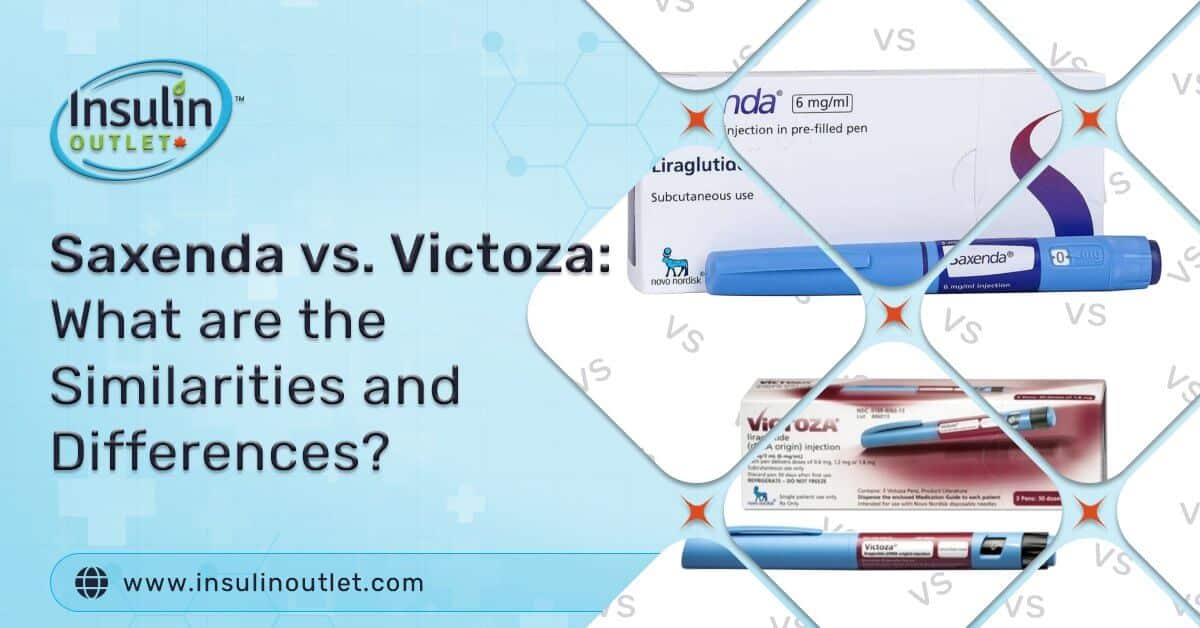
In today’s feature, we have the battle of liraglutide: Saxenda vs. Victoza! There are different types of diabetic drugs doctors prescribe to lower high blood sugar in diabetic patients, and two very common ones are Victoza and Saxenda.
These medications are used for the management of diabetes, and they contain the same active drug – liraglutide, which is similar to a naturally occurring hormone that controls blood sugar and insulin levels.
Recently, they have become rather popular in the weight-loss conversations around the globe but they do differentiate in functionality and purpose.
These drugs may have similarities, but they are approved by healthcare professionals for different uses. While Victoza is approved for diet improvement and to improve blood sugar levels in the bloodstream, it is mainly prescribed to people who are 10 years and above who are Type 2. Meaning it cannot be administered to children below the age of 10.
Also, Victoza is used for mitigating certain risks that can lead to heart problems in adults with Type 2 diabetes that may lead to major adverse cardiovascular events. It also has the same ingredients as Saxenda (mainly Liraglutide) and does help with weight loss. Although both are meant for Type 2 diabetics, they both are usually prescribed for different scenarios.
Saxenda is used for chronic weight management in people who are 12 years and above who are also dealing with diabetic conditions. It has very similar results to the use of Ozempic and Trulicity.
Saxenda and Victoza are basically generic names given to both drugs, but they have certain similarities and differences. In this article, we explore both in detail and explain how they work and what they are used for.
Table Of Contents
ToggleSaxenda
Let’s start with Saxenda. Saxenda is an injection drug used for treating obesity in people who are 12 years and above, and their body mass index (BMI) is equal to or higher than 30kg/m2.
This drug is quite popular as it has regularly been prescribed by doctors. It is commonly used by people suffering from diabetes because it is a very effective weight loss medication.
You probably may not know, but many people with diabetes suffer from excess weight, which affects their health. By managing their weight properly, they are able to control their cholesterol intake, control blood pressure, and prevent their blood sugar level from spiking. It is also important to incorporate the correct foods in your diet, while you are taking Saxenda.
This drug is not taken in isolation but is administered in conjunction with a healthy diet and regular exercise program. Saxenda has been approved by the FDA and as of late, many non-diabetics are taking Saxenda for strictly weight-loss purposes.

Victoza
Victoza is another injectable medication used to treat cardiovascular disorders in people who have Type 2 diabetes. This medication is prescribed alongside a healthy diet and exercise program.
Victoza is administered to control blood sugar levels in patients 10 years and older and reduce the risks of certain heart conditions like heart attacks, stroke, and heart disease.
This medication is administered once a day at the same time each day to establish a regular and consistent circle.
Similarities & Differences Between Saxenda and Victoza
These diabetes medications have certain similarities and differences you should know about. Let’s review some of them below.
Saxenda and Victoza – Similarities
Saxenda and Victoza are produced by the same company named Novo Nordisk. Secondly, they contain the same essential ingredient called liraglutide. For administration, the user uses an injectable pen subcutaneously.
This ingredient then transforms into incretin, which further stimulates the pancreas to produce and release insulin into the bloodstream when the sugar level becomes too high.
Saxenda and Victoza are classified as GLP-1 agonists in the medical field because they mimic incretin in the human body, which gives you a feeling of satiety (a feeling of satisfaction like you just had food).
Initially, they were both used to treat diabetes. When people usually think of diabetic medications, they are usually thinking of insulin (such as Humulin and Humalog). However many diabetics take additional medication to manage their diabetes.
Liraglutide
Saxenda and Victoza both contain liraglutide, which is an active drug. Being GLP-1 agonists, they work in almost the same way to slow down gastric emptying, trigger insulin release, and decrease appetite.
Basically, these drugs limit the hunger signals that your brain creates. No hunger leads to no good, which leads to weight loss. It is a simple concept but not as simple to implement in real life (one of our biological functions is to eat).
Side Effects
As with all drugs, Saxenda and Victoza have their side effects. Since they are active drugs that contain the same ingredient, they post the same reactions in users. So, if you are in the process of using any of them, bear in mind that you may experience one or more of these side effects.
This is why it is dangerous and ill-advised to self-medicate. It is essential to consult your doctor for directions and prescriptions.
Mild side effects of Victoza and Saxenda:
- Headache
- Nausea
- Indigestion
- Diarrhea
- Low appetite
- Upper respiratory tract infections
- Injection site itching, rashes, redness
Serious side effects of Victoza and Saxenda:
- Serious allergic reactions
- Trouble swallowing
- Severe abdominal pain
- Pancreatitis
- Low blood sugar
- Potential kidney failure
- May lead to thyroid cancer
(more information in FDA Warnings)

Saxenda and Victoza – Key Differences
Both drugs have their differences as well. Although they are both GLP-agonist drugs, they cannot be used interchangeably. Saxenda is used by diabetics to control obesity and to expedite weight loss, while Victoza is has been approved by the FDA to control blood sugar in the bloodstream.
However, weight-loss clinics have been prescribing Victoza to battle against obesity. If you decide you want to switch between Saxenda and Victoza, you must have this approval from your healthcare practitioner. Do not switch or take any medications that have not been prescribed to you to avoid potential drug interactions.
Dosage, Forms and Administration
So, how do Saxenda and Victoza appear over the counter? Both are sold in liquid form in prefilled injection pens, with each pen holding 18mg of liraglutide in a 3m solution.
To use any of them, you will have to inject them once a day. However, their dosages may be different (depending on the guidance of your healthcare professional).
Generally speaking, patients who use Saxenda require a higher dosage than Victoza. In the first few weeks, you start slowly, but after five weeks, with your body already used to it, your doctor may recommend an increase. On average, the daily recommended dosage is 3mg per day.
For Victoza, the dosages vary between 0.6mg, 1.2mg, and 1.8mg daily. So, how much you use will depend on your condition and the doctor’s recommendation. Do not take a dosage of medication from what you have read on the internet. Always listen to your doctor’s advice.
FDA Approvals for Saxenda and Victoza
Although we have addressed their uses, it is important to provide more details regarding what the FDA has approved them for.
Victoza: Based on FDA approval, Victoza is used to improve blood sugar or to manage it effectively and for weight loss. The FDA approved this drug for Type 2 diabetics.
Saxenda: Based on FDA approval, Saxenda is used with healthy dieting and regular exercising for siding weight loss. It is commonly recommended for use in people with a body mass index equal to or higher than 30kg/m2 and for children and anyone who is 12 years or older and weighs more than 132 lbs, has a BMI equal to or higher than 27kg/m2.
Note: Saxenda is not used to control blood sugar; neither is it prescribed for those with Type 1 diabetes or children under 12 years of age. As the FDA has pointed out, Saxenda and Victoza may contain the same liraglutide agent but they are used for different purposes.
FDA Warnings
Also, note that the FDA has placed certain boxed warnings on both drugs to enable patients and doctors to make informed decisions, should they choose to use these drugs.
Boxed warnings are basically notifications to show that these drugs may cause serious side effects, which may be dangerous for some patients. One of the more serious boxed warnings to be aware of is thyroid tumors.
Saxenda and Victoza may increase the risk of thyroid tumors, according to the FDA. This was discovered after they were both used in animals. So, people with a medical family history of medullary thyroid carcinoma are advised against using Saxenda or Victoza. Also, those with a rare form of multiple endocrine Type 2 neoplasia cancer are advised against usage.
Patients are advised to contact their doctor for immediate medical attention if they begin to notice any symptoms of thyroid cancer while using these medications. Common symptoms may include but are not limited to shortness of breath, hoarseness, lumps in the neck, and swallowing difficulty.
Other Warnings
- Kidney problems: For those with kidney complications, Saxenda and Victoza, may worsen it, so your doctor may want to monitor your kidney health as you take it.
- Slow digestion: They both cause slow digestion, so after eating or drinking, it may take a longer time for your stomach to become empty
- Pregnancy and breastfeeding: It remains unclear whether they can be used by pregnant women or breastfeeding mothers.
Furthermore, some users report feeling depressed and nursing suicidal thoughts after using Saxenda. For those who experience these or any other mental health condition, it is important to talk to a doctor. Using Saxenda if you experience any of these mental issues is not advisable.

Summary
Saxenda and Victoza are two medications that contain the same active ingredient – liraglutide. They are produced by the same manufacturer but perform different functions. Saxenda and Victoza have become fairly popular in the past year, as their results for weight loss have gained the attention of many.
Based on the reports published by practitioners and the feedback from Type 2 diabetes users, both medications have proven to be very effective. People with weight issues have used Saxenda to either control their weight or lose weight. Victoza has also equally been beneficial. Hence, these medications are becoming popular outside of the diabetes community.
Please note that these drugs were designed for diabetics. If you are interested in using any medication, it is essential and vital to discuss the possibility with your doctor. Do not purchase or administer any medication without the approval of your healthcare professional.
Victoza vs. Saxenda FAQs
How do Saxenda and Victoza work?
Both medications belong to a class of drugs known as GLP-1 receptor agonists. They work by mimicking the effects of glucagon-like peptide-1 (GLP-1), a hormone that regulates blood glucose and appetite. They can help control blood sugar and reduce food intake.
What are the common uses of Saxenda and Victoza?
Saxenda is primarily used for weight management in individuals with obesity or those struggling to lose weight, in conjunction with a reduced-calorie diet and increased physical activity. Victoza is prescribed for people with type 2 diabetes to help lower blood sugar levels and improve glycemic control.
Are there any differences in dosing?
Yes, Saxenda is typically prescribed at a higher dose (3 mg) for weight management, while Victoza is prescribed at lower doses (1.2 mg or 1.8 mg) for diabetes management.
Do Saxenda and Victoza have similar side effects?
Yes, both medications can cause similar side effects, such as nausea, vomiting, diarrhea, and constipation. However, the side effects may vary in intensity and frequency between individuals.
Can Saxenda be used for diabetes management?
Saxenda is not approved for the treatment of diabetes. It is specifically indicated for weight management. If you have diabetes and need a GLP-1 receptor agonist, your healthcare provider is more likely to prescribe Victoza.
Can Victoza be used for weight loss?
While Victoza is primarily intended for diabetes management, some healthcare providers may prescribe it off-label as a weight loss drug. However, Saxenda is an FDA-approved medication specifically designed for weight management.
How are Saxenda and Victoza administered?
Both Saxenda and Victoza are administered by subcutaneous injection using a pre-filled pen. They are usually injected once a day.
Share:












